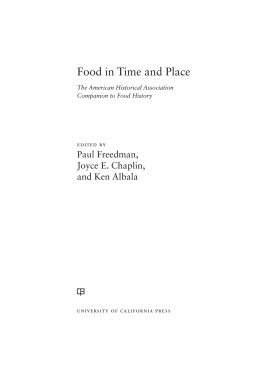Acknowledgments
Food in Time and Place is intended to offer orientation to several fields within food history across geographical areas, chronological periods, and topics. There are, for example, chapters on Africa, on European cuisine before the modern era, and about immigrants and food. We have tried to achieve a balance among world cultures and historical periods. As a work intended for an audience interested in history, this collection emphasizes the past and the context it provides for present aspects of food consumption.
The impetus for this project came from the American Historical Association (AHA), particularly Professor Iris Berger, formerly the Associations elected vice-president for research, and former Executive Director Robert Townsend. The editors are grateful to them for their initiative and encouragement, as well as for the support of their successors, Professor John McNeil of the Research Division and current Director James Grossman.
The original intention of the AHA was to produce a book about teaching the history of food. While we have expanded in order to interest more general readers, not just teachers, we have tried to offer guidance to college and high school teachers about the state of various questions in the fields covered. The editors are grateful to Kate Marshall of the University of California Press not only for seeing this complicated work through to completion, but for suggesting that the scope of the volume be expanded and its chapters be broadened beyond pedagogy.
The editors acknowledge with thanks the careful readings of outside referees, Lizzie Collingham of the University of Warwick, Matthew Booker at North Carolina State University, and Daniel Bender from the University of Toronto. We are especially grateful to Agnieszka Rec, a doctoral student at Yale University, who tirelessly and meticulously edited the chapters and put them in consistent order to ready them for publication.
Our gratitude is particularly directed to our contributors, whose work has shown us, and will we trust show the reader, many unexpected and thought provoking aspects of food studies. The patience, dedication, and suggestions of our authors have benefited us and made us hope that this book will be a unique contribution to an increasingly busy field.
Preface
PAUL FREEDMAN
One expression of the recent surge of interest in the history of food is the appearance of many more books and essays on the subject than were available just a few years ago. The small number of large books surveying food history in a general way has now been supplemented by both more ambitious and more specialized works: multivolume treatments across an extensive chronology, studies of food history as part of the interdisciplinary field of food studies, even accounts of the historiography of food. The purpose of the present book is somewhat different and twofold: first, to provide a convenient handbook presenting a geographically, chronologically, and topically broad range of food history, and second, to serve as a resource for teachers of food history, including those who are thinking about putting together such a course, those who have already taught one, and historians who would like to add or increase a food component in courses oriented towards one nation (e.g., French history), period (e.g., medieval history), or topic (e.g., history of immigration). This preface outlines the situation of a field that can no longer be described as emerging, but that has achieved visibility and widely acknowledged importance. Here we want to suggest some aspects of the current situation of food history and look at how chapters in this book can contribute to its stated purpose.
In the past a preface of this sort would have advocated the importance of the field of food history to a presumably skeptical audience of historians
The popularity of food history among students and the expansion of academic programs, journals, and conferences on the subject make it clear that there is a durable interest in food as an expression of culture, a sign of identity, and an index of social as well as technological change. Food stands at the junction of contemporary concerns such as environmental degradation, public health, gender roles, globalization, and the erosion or preservation of cultural products and collective traditions. Efforts to protect food products and social identity are exemplified by such phenomena as the 1970s Campaign for Real Ale in Britain, the international Slow Food movement, and the proliferation of farmers markets in the United States. Historians have been able to show some of the origins or early evolution of contemporary problems such as the politics of farming and water consumption and also of cultural perceptions of dieting, obesity, and body image.
The relevance of food history to a number of intersecting topics explains the answer to the question posed by Warren Belasco in the first chapter of this volume, Why has food studies taken off? Yet it remains surprising that historians have been less receptive than social scientists to food as a subject of study. Belasco describes some of this resistance, and many of us of a certain age can recollect amused or slightly appalled responses to proposals to study restaurants, cooking styles, or immigrants cuisine. Anthropologists, on the other hand, have always concerned themselves with the so-called foodways of the societies they live with, not just what is eaten but how food is distributed hierarchically and with what sorts of gestures it is consumed. Even anthropologists who were not writing exhaustive descriptions of material culture or kinship relations placed food at the center of their accounts. Clifford Geertzs classic study of symbolic anthropology, The Religion of Java (published in 1960), begins with the slametan, a ceremonial meal, as a key to Javanese views of the world of matter and spirit. The food is wrapped in banana leaves and served by women to men who are seated on the floor. This informal but ritualized meal marks good and bad events: births, deaths, misfortunes, escapes from danger, arrivals, departures.










